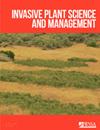Relationship between local-scale topography and vegetation on the invasive C4 perennial bunchgrass buffelgrass (Pennisetum ciliare) size and reproduction
IF 1.2
4区 生物学
Q3 PLANT SCIENCES
引用次数: 0
Abstract
Abstract Buffelgrass [Pennisetum ciliare (L.) Link] is an invasive C4 perennial bunchgrass that is a threat to biodiversity in aridlands in the Americas and Australia. Topography influences P. ciliare occurrence at large spatial scales, but further investigation into the relationship between local-scale topography and P. ciliare growth and reproduction would be beneficial. Further, density-dependent effects on P. ciliare growth and reproduction have been demonstrated in greenhouse experiments, but the extent to which density dependence influences P. ciliare in natural populations warrants further investigation. Here we present a study on the relationships between local-scale topography (aspect and slope gradient) and vegetation characteristics (shrub cover, P. ciliare cover, and P. ciliare density) and their interactions on individual P. ciliare plant size and reproduction. We measured slope gradient, aspect, shrub cover, P. ciliare cover, P. ciliare density, and the total number of live culms and reproductive culms of 10 P. ciliare plants in 33 4 by 4 m plots located in 11 transects at the Desert Laboratory at Tumamoc Hill, Tucson, AZ, USA. We modeled the relationships at the local scale of (1) P. ciliare cover and density with aspect and slope gradient and (2) P. ciliare size and reproduction with abiotic (slope gradient and aspect) and biotic (P. ciliare cover and density and native shrub and cacti cover) characteristics. Aspect and slope gradient were poor predictors of P. ciliare cover and density in already invaded sites at the scale of our plots. However, aspect had a significant relationship with P. ciliare plant size and reproduction. Pennisetum ciliare plants on south-facing aspects were larger and produced more reproductive culms than plants on other aspects. Further, we found no relationship between P. ciliare density and P. ciliare plant size and reproduction. Shrub cover was positively correlated with P. ciliare reproduction. South-facing aspects are likely most vulnerable to fast spread and infilling by new P. ciliare introductions.入侵C4多年生束草水牛草(Pennisetum ciliare)大小和繁殖与当地地形和植被的关系
摘要羊尾草[Pennisetum ciliare (L.)]是一种入侵的C4多年生束草,对美洲和澳大利亚干旱地区的生物多样性构成威胁。在大空间尺度上,地形影响着纤毛的发生,但进一步研究局地地形与纤毛生长繁殖的关系将是有益的。此外,密度依赖性对纤毛虫生长和繁殖的影响已在温室实验中得到证实,但密度依赖性对自然种群纤毛虫的影响程度有待进一步研究。本文研究了局地尺度地形(坡向和坡度)与植被特征(灌木盖度、毛缕盖度和毛缕密度)的关系及其对毛缕单株大小和繁殖的影响。研究人员在美国亚利桑那州图森市图马莫克山沙漠实验室的11个样地测量了33个4 × 4 m样地的10种纤毛植物的坡度、坡向、灌木覆盖、纤毛覆盖、纤毛密度以及活秆和生殖秆的总数。在局地尺度上,模拟了(1)纤毛盖度和密度与坡向和坡向的关系,(2)纤毛大小和繁殖与非生物(坡向和坡向)和生物(纤毛盖度和密度、原生灌木和仙人掌盖度)特征的关系。坡向和坡度不能很好地预测已入侵样地的毛缕盖度和密度。坡向与纤毛草植株大小和繁殖有显著的关系。朝南的毛狼尾草植株比其他植株更大,产生更多的生殖秆。此外,我们发现纤毛密度与纤毛的植株大小和繁殖没有关系。灌丛盖度与毛菖蒲繁殖呈正相关。南向植物可能最容易被新引进的纤毛虫快速传播和填充。
本文章由计算机程序翻译,如有差异,请以英文原文为准。
求助全文
约1分钟内获得全文
求助全文
来源期刊

Invasive Plant Science and Management
PLANT SCIENCES-
CiteScore
2.20
自引率
9.10%
发文量
24
审稿时长
6-12 weeks
期刊介绍:
Invasive Plant Science and Management (IPSM) is an online peer-reviewed journal focusing on fundamental and applied research on invasive plant biology, ecology, management, and restoration of invaded non-crop areas, and on other aspects relevant to invasive species, including educational activities and policy issues. Topics include the biology and ecology of invasive plants in rangeland, prairie, pasture, wildland, forestry, riparian, wetland, aquatic, recreational, rights-of-ways, and other non-crop (parks, preserves, natural areas) settings; genetics of invasive plants; social, ecological, and economic impacts of invasive plants and their management; design, efficacy, and integration of control tools; land restoration and rehabilitation; effects of management on soil, air, water, and wildlife; education, extension, and outreach methods and resources; technology and product reports; mapping and remote sensing, inventory and monitoring; technology transfer tools; case study reports; and regulatory issues.
 求助内容:
求助内容: 应助结果提醒方式:
应助结果提醒方式:


